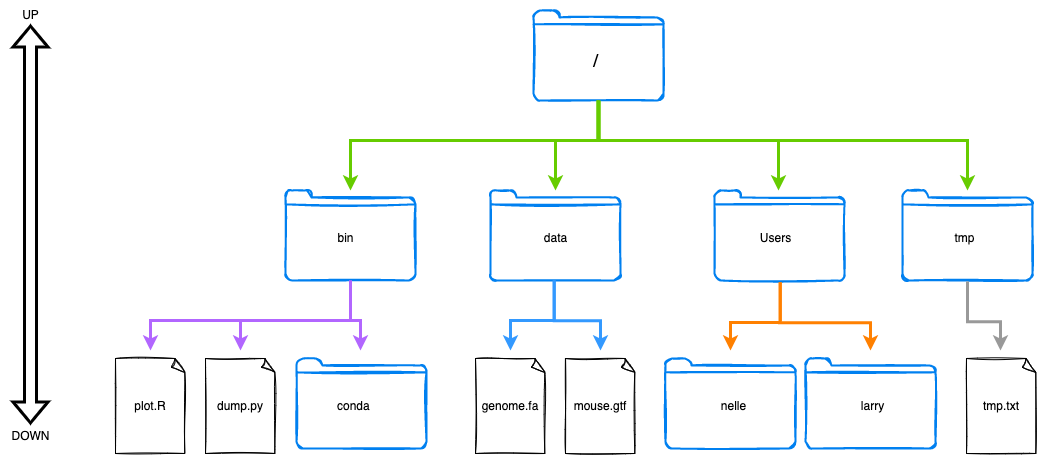Navigating Files and Directories
File System
The file system manages and organizes our files and directories.
- Files contain information, such as text or images.
- Directories (what we often refer to as folders) contain files and other directories.
We can view this as a sort of “family tree” (or more like a root system), where there are “parent” and “child” directories. In the example file system below there are 5 sets of parent-child relationships.

Two of the 5 sets of parent-child relationships are shown below. Can you think of the other sets?
Relationship 1
flowchart TB A["/"] --> B[bin] A --> C[data] A --> D[Users] A --> E[tmp]
Relationship 2
flowchart TB A[Users] --> B[nelle] A --> C[larry]
The file system also has a directionality, such that the directory that encompasses all other directories and files is at the top of the system and all other files or directories are below it. This top-most directory is called the root directory and is shown with the /.
Paths
As you can see above, the directories, files, and subdirectories of a file system are connected. The route one would take from one directory or file to another is called a “path”. The path also describes the location of a file or directory within the file system. There are two types of paths:
- absolute path – the path taken from the top-most directory (root,
/), to the specified file or directory. The absolute path always starts with/. - relative path – the path taken from the present working direcotry to the specified file or directory. The relative path never starts with
/.
The path to a few files is shown below.
| Target | Absolute Path | Relative Path (from the /bin directory) |
|---|---|---|
plot.R |
/bin/plot.R |
plot.R |
conda |
/bin/conda |
conda |
What is the absolute and relative path to the mouse.gtf file if we are in the /data directory?
| Target | Absolute Path | Relative Path (from the /data directory) |
|
|---|---|---|---|
mouse.gtf |
/data/mouse.gtf |
mouse.gtf |
|
Working Directory
When we work in the command line, we are working in a specific location of the file system, called the “current working directory”.
How do we know where we are? We can use a command for that.
pwd command
pwdstands for print working directory- prints out working directory location to the screen
Let’s try it. Run the pwd command in your terminal.
bash-3.2$ pwd
/Users/csifuentes
bash-3.2$In the response above, the path of my working directory is /Users/csifuentes.
Listing files and directories
When we’re using a terminal and in a specific directory, we often want to know which files and directories are in our current working directory. How can we do that?
We use the ls command.
Let’s try it. Run the ls command in your terminal.
bash-3.2$ ls
Applications Movies RNASeq
Desktop Music SoftwareCarpentryStuffs
Documents Pictures VirtualBox VMs
Downloads Public miniconda3
Library RNASeqAnalysis.R notes
bash-3.2$That didn’t work as we wanted it to.
Let’s modify the the behavior of the ls command using the -F flag to list formats.
(base) czimacos3304:~ csifuentes$ ls -F
Applications/ Downloads/ Movies/ VirtualBox VMs/ miniconda/ setup.sh
CytoscapeConfiguration/ Dropbox-Uploader/ Music/ bin/ miniconda3/ single-cell-curation/
Desktop/ EnsDb.Xtropicalis.v101/ Pictures/ course/ notebooks/
Documents/ Library/ Public/ igv/ notes/In the output, we see trailing symbols
/means the preceding is a directory
@means the preceding is a link
- files will have nothing preceding
Cleaning up
As we work in the terminal commands and outputs are printed to the screen. At times this becomes messy and it will take up the entire terminal screen, in time. We can clear the terminal using the clear commmand.
clear command
clearstands for clear :)- clears the current terminal shell session
(base) czimacos3304:~ csifuentes$ ls
Applications Downloads Movies VirtualBox VMs miniconda setup.sh
CytoscapeConfiguration Dropbox-Uploader Music bin miniconda3 single-cell-curation
Desktop EnsDb.Xtropicalis.v101 Pictures course notebooks
Documents Library Public igv notes
(base) czimacos3304:~ csifuentes$ ks
bash: ks: command not found
(base) czimacos3304:~ csifuentes$ ls
Applications Downloads Movies VirtualBox VMs miniconda setup.sh
CytoscapeConfiguration Dropbox-Uploader Music bin miniconda3 single-cell-curation
Desktop EnsDb.Xtropicalis.v101 Pictures course notebooks
Documents Library Public igv notes
(base) czimacos3304:~ csifuentes$ ls -F
Applications/ Downloads/ Movies/ VirtualBox VMs/ miniconda/ setup.sh
CytoscapeConfiguration/ Dropbox-Uploader/ Music/ bin/ miniconda3/ single-cell-curation/
Desktop/ EnsDb.Xtropicalis.v101/ Pictures/ course/ notebooks/
Documents/ Library/ Public/ igv/ notes/
(base) czimacos3304:~ csifuentes$ clear(base) czimacos3304:~ csifuentes$ History
Now we have a cleared terminal screen – nice and clean. But what if we needed to know some of the commands we ran previously? Don’t worry, the terminal keeps the command history.
history command
historystands for history- prints the last x number of commands that were run
(base) czimacos3304:~ csifuentes$ history
16 pwd
17 ls
18 ks
19 ls
20 ls -F
21 clear
22 history
(base) czimacos3304:~ csifuentes$ We can see the most recent command by tapping the “up arrow” on our keyboard. This can be very helpful when we want to run the same command (or edit the command slightly) but do not want to retype the entire command.
Exploring other directories
List in other directories
So far we have only used ls to list items in our current working directory. Let’s see take a look at other directories. We can do this by passing a directory as the target of the ls command.
Using the test data, list the files in data-shell and data/shell/creatures.